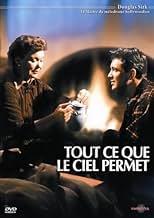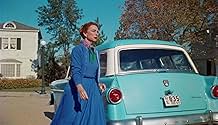NOTE IMDb
7,6/10
17 k
MA NOTE
Une veuve de la haute société tombe amoureuse d'un pépiniériste terre-à-terre beaucoup plus jeune, au grand désespoir de ses enfants et de ses amis du country club.Une veuve de la haute société tombe amoureuse d'un pépiniériste terre-à-terre beaucoup plus jeune, au grand désespoir de ses enfants et de ses amis du country club.Une veuve de la haute société tombe amoureuse d'un pépiniériste terre-à-terre beaucoup plus jeune, au grand désespoir de ses enfants et de ses amis du country club.
- Réalisation
- Scénario
- Casting principal
- Récompenses
- 2 victoires au total
Jacqueline deWit
- Mona Plash
- (as Jacqueline de Wit)
Helen Andrews
- Myrtle
- (non crédité)
Commentaire à la une
At times, the aesthetic appeal of a film is so overwhelming, it surpasses the draw of the big-name stars and plot. And "All That Heaven Allows" is one of those rare examples. Anyone familiar with Douglas Sirk-directed projects knows his grandiose style. And this 1955 masterpiece sums up the best of Sirk drama, with the surface sheen, thundering music, noted stars and biting social commentary. This film, in fact, is so beautiful, that it requires repeated viewings just to be able to take it all in.
Jane Wyman and Rock Hudson re-team from Sirk's inferior "Magnificent Obsession" that was such a hit the year before. In this story, Wyman plays a wealthy widow bound to the claustrophobic confines of her uppity New England town. Her friends and two grown children do their best to convince her to marry Harvey, a stuffy and older neighborhood bachelor. But Wyman wants more. She ends up falling for her younger gardener, played by Hudson. After bonding over the virtues of the silver-tipped spruce, they embark on a love affair which is rejected by the community and Wyman's own children. They feel she is far too upstanding to be with a gardener. The reluctance of those around her to accept this relationship cause Wyman to have to choose between love or respect from her town.
Sirk takes what is a sappy, predictable tale and turns it into a visual feast. This is true eye candy for film buffs. Sirk sets the stage for this story against a heightened background of the reds, golds and yellows of a New England autumn. Every detail from Agnes Moorehead's red hair to sunsets to Wyman's lipstick and even the cars is given the Technicolor treatment to the max. Sirk's knack for visual irony is also heavily present throughout. The film opens with a shot of the town's clocktower with pigeons roosting. The pigeons are divided into two groups - a gaggle of black pigeons representing the townspeople on one end, and on the other are two white pigeons nuzzling, representing Wyman and Hudson and the division they face in this community. This is just for starters. Other stunning examples are when Sirk uses shades of blues and greys and reds to convey character's feelings of sadness or anger. And of course there is the famous television set scene. And through all of this emotion and cotton candy extravaganza is Frank Skinner's lush score that soars in all the right places. "All That Heaven Allows" is a first-rate classic that is a must for fans of Sirk or anyone who are devotees of lush melodramas from the studio heyday.
Jane Wyman and Rock Hudson re-team from Sirk's inferior "Magnificent Obsession" that was such a hit the year before. In this story, Wyman plays a wealthy widow bound to the claustrophobic confines of her uppity New England town. Her friends and two grown children do their best to convince her to marry Harvey, a stuffy and older neighborhood bachelor. But Wyman wants more. She ends up falling for her younger gardener, played by Hudson. After bonding over the virtues of the silver-tipped spruce, they embark on a love affair which is rejected by the community and Wyman's own children. They feel she is far too upstanding to be with a gardener. The reluctance of those around her to accept this relationship cause Wyman to have to choose between love or respect from her town.
Sirk takes what is a sappy, predictable tale and turns it into a visual feast. This is true eye candy for film buffs. Sirk sets the stage for this story against a heightened background of the reds, golds and yellows of a New England autumn. Every detail from Agnes Moorehead's red hair to sunsets to Wyman's lipstick and even the cars is given the Technicolor treatment to the max. Sirk's knack for visual irony is also heavily present throughout. The film opens with a shot of the town's clocktower with pigeons roosting. The pigeons are divided into two groups - a gaggle of black pigeons representing the townspeople on one end, and on the other are two white pigeons nuzzling, representing Wyman and Hudson and the division they face in this community. This is just for starters. Other stunning examples are when Sirk uses shades of blues and greys and reds to convey character's feelings of sadness or anger. And of course there is the famous television set scene. And through all of this emotion and cotton candy extravaganza is Frank Skinner's lush score that soars in all the right places. "All That Heaven Allows" is a first-rate classic that is a must for fans of Sirk or anyone who are devotees of lush melodramas from the studio heyday.
- Michael27-1
- 10 juil. 2005
- Permalien
Histoire
Le saviez-vous
- AnecdotesThe façade later cannibalized to make up the front of the Bates home in Psychose (1960) is visible a few houses up from Cary Scott's (Jane Wyman's) block.
- GaffesWhen the deer runs away, a crew member can be seen hiding behind the automobile.
- Citations
Ron Kirby: Mick discovered for himself that he had to make his own decisions, that he had to be a man.
Cary Scott: And you want *me* to be a man?
Ron Kirby: [Giving her a knowing smile] Only in that one way.
- ConnexionsEdited into Quand la peur dévore l'âme (2007)
Meilleurs choix
Connectez-vous pour évaluer et suivre la liste de favoris afin de recevoir des recommandations personnalisées
- How long is All That Heaven Allows?Alimenté par Alexa
Détails
- Date de sortie
- Pays d’origine
- Langue
- Aussi connu sous le nom de
- All That Heaven Allows
- Lieux de tournage
- Société de production
- Voir plus de crédits d'entreprise sur IMDbPro
Box-office
- Montant brut mondial
- 287 $US
- Durée1 heure 29 minutes
- Couleur
Contribuer à cette page
Suggérer une modification ou ajouter du contenu manquant

Lacune principale
By what name was Tout ce que le ciel permet (1955) officially released in India in English?
Répondre




























